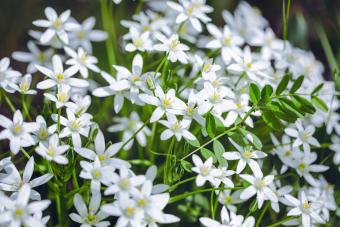
Whether you call them rain lilies, fairy lilies, or rainflowers, zephyranthes are definitely a plant worth growing. These bulbs, and the delicate flowers that grow from them, are wonderful additions to the summer and fall garden.

Growing Rain Lilies in Your Garden
Zephyranthes, more commonly known as rain lilies, are bulbs that bloom in summer in shades of pink, white, and orange. They can be confusing, since they're somewhat similar in size and shape to crocuses, which, depending on the type, bloom in spring or fall. Rain lilies aren't very common, but they should be! These easy-care, reliable bulbs add another dose of color to the summer garden, but they also can sometimes bloom more than once in a season. They'll often have their most robust bloom period in early summer, and then, after periods of heavy rain, they may very well bloom again, which is why they're known as rain lilies.
Zephyranthes grow to about six to 12 inches tall and are hardy in Zones 7 through 11. If you live in a colder climate, you can grow rain lilies as an annual, digging them up before frost and planting them again after danger of spring frost has passed, just as you would for dahlias and gladiolus.

Where to Plant Zephyranthes: Light and Soil Requirements
Rain lilies need a spot in full sun. The soil should be average to rich, and they grow well in neutral to mildly acidic conditions. Plant the bulbs 4-8 inches deep. Since they're fairly small flowers, they look best planted in groups or drifts for maximum impact. Their grassy foliage also makes an attractive edging to a garden, even when the plants aren't in bloom.
Watering and Fertilizing
As you might guess from their name, rain lilies perform best with regular watering. They can withstand drought, but they won't bloom until they've gotten adequate water, either via a nice, soaking rain, or by regular irrigation after the foliage appears in spring.
Rain lilies really don't need to be fertilized, though topdressing the area with compost in early spring is never a bad idea, since it adds fertility to the soil and helps it retain moisture longer.
Pruning
You don't need to deadhead zephyranthes unless the faded flower head bothers you. The foliage is thin and grass-like. It will turn yellow and die back toward the end of the season. If you want to neaten up the area, you can cut off the foliage after it's turned fully brown and withered, but it isn't necessary to do so.
Rain Lily Pests and Diseases
Rain lilies are generally pest-free and aren't susceptible to many diseases. The most common issue you might find yourself dealing with is rot, and that's really only a problem if the bulbs are planted in an area with poorly draining, soggy soil.
Propagating Rain Lilies
Rain lilies spread via producing bulblets, which eventually grow large enough to bloom as well. This plant does well growing in somewhat crowded conditions, but if you want to transplant the bulblets to other areas, you can dig them up in spring or fall and plant them four to eight inches deep in their new location.
Beautiful Rain Lilies to Grow in Your Garden
There are several gorgeous varieties of rain lily to grow in your garden. Whether you're looking for crisp white blooms or a range of soft pastels, you can find a zephyranthes cultivar that will work wonderfully in your landscape.
Zephyranthes Candida
Zephyranthes candida has silvery-white blooms that are produced in late summer through early autumn. This is one of the most common and easily-found types of rain lilies.

Zephyranthes 'Star of Bethlehem'
'Star of Bethlehem' rain lilies bloom in vibrant orange in late summer. The petals also have a bright yellow streak that makes the orange color pop even more.
Zephyranthes 'Lily Pies'
This stunning rain lily has soft pink blooms that fade to pure white at the center of the flower. The foliage is a deep, glossy green which contrasts beautifully with the blooms.

Zephyranthes 'Ajax'
If you love yellow flowers, this variety is for you. The pale yellow, star-shaped flowers grow on plants that reach about eight inches tall. The bright yellow stamens add to the showy appearance of 'Ajax.'
What to Plant With Rain Lilies
Zephyranthes grows wonderfully in containers, which is a great solution for gardeners in colder zones; you can simply move the container to a protected area to overwinter the bulbs, then move it outside again next year.

When planting rain lily in the garden, any of these plants play well with it:
- Sedum
- Lysimachia
- Lantana
- Begonias
- Impatiens
- Nasturtium
Small Flowers, Big Impact
Zephyranthes deserve so much more attention than they currently get. Beautiful, easy to grow, and generally pest-free, in addition to being available in a plethora of shades--what more could any gardener ask for?







